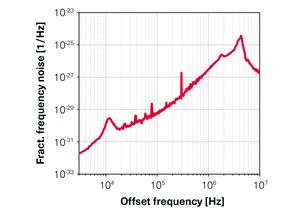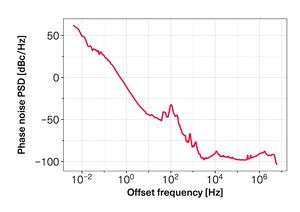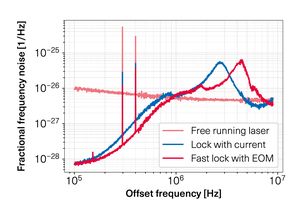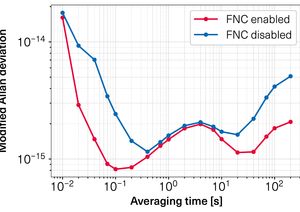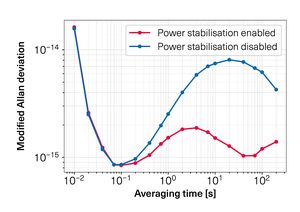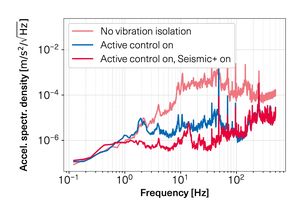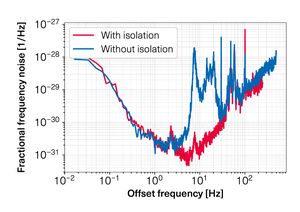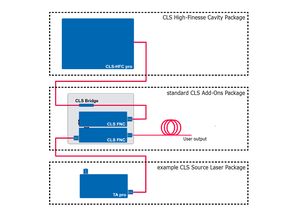 Frequency stability in terms of modified Allan deviation after linear drift removal extracted via cross-correlation analysis of beat-notes with two reference lasers.
Frequency stability in terms of modified Allan deviation after linear drift removal extracted via cross-correlation analysis of beat-notes with two reference lasers.

MCLS
Ultra-stable clock laser systems for quantum computing and optical clocks
- Long coherence time for high qubit fidelity
- Exceptional frequency stability for elevated optical clock performance
- Complete T-RACK
TOPTICA´s clock laser systems are diode lasers whose linewidth is reduced to less than 1 Hz via frequency stabilization to high-finesse optical ULE cavities. These systems yield highest frequency stability far beyond 1 second integration time to drive the very narrow atomic clock transitions in neutral atoms like Yb, Sr and ions like Yb+, Sr+, Ca+ and Ba+. Available wavelengths of the MCLS cover, among others, the most popular species with Top Sellers at 435 nm (Yb+, MCLS at 871 nm + SHG), 578 nm (neutral Yb, MCLS at 1156 + SHG), 674 nm (Sr+), 698 nm (neutral Sr), 729 nm (Ca+), 1550 nm (DFC Core + and Er+) and 1762 nm (Ba+). Beyond that, custom wavelengths are available upon request.
The MCLS is designed to maintain its exceptional frequency stability also under out-of-the lab conditions. Its robust design, excellent passive shielding and active vibration compensation make it resilient towards external acoustic and seismic vibrations. A high-end temperature stabilization system guarantees highest stability towards temperature fluctuations. This resilience towards external noise makes the MCLS a perfect choice for the operation of quantum computers, optical clocks and quantum sensors which are moving out of the labs to real world customers.
The robust design is also the key to extend the excellent frequency stability of the CLS far beyond 1 second of measurement time with residual non-linear fluctuations sufficiently suppressed for low quantum-simulator downtime and elevated optical clock performance.
The MCLS integration within the TOPTICA T-RACK does not compromise on performance. It offers a complete solution where greatest care is taken for electrical power supply and cable management. This solution is ideal for anyone with limited space and enables an easy transport of the system.
The complete system is controlled with one interface which is hosted by the DLC pro and can be accessed with the PC GUI TOPAS. The interface covers control, monitoring and locking of the laser, and supports full remote operation. This single interface also allows for easy integration into the user experiment control via a convenient programming SDK.
-
Specification
Linewidth at 1 s integration time < 1 Hz Fractional frequency stability* Integration time 1 s 10 s 100 s Modified Allan deviation, linear drift removed < 2 x 10-15 < 2 x 10-15 < 3 x 10-15 Typical phase noise* at 729 nm (source laser with F option) Offset frequency 10 Hz 10 kHz 1 MHz Phase noise power spectral density -42 dBc/Hz -90 dBc/Hz -90 dBc/Hz Typical linear drift rate (12 months after installation) < 150 mHz/s Loop bandwidth (depends on the source laser) Up to 4.5 MHz Free spectral range of high-finesse cavity 1.5 GHz Height with / without eye bolts ≤ 2025 mm / 1970 mm Lateral dimensions (W x D) 600 mm x 800 mm Weight** (CLS-HFC pro) ≤ 270 kg Power consumption* 215 W *Configuration with standard CLS Add-Ons Package
**CLS Source Laser Package and CLS Add-Ons Package not included -
Additional Information
-
Options
- CLS FNC: All optical fibers in the system can be actively stabilized to ensure that phase noise introduced by the fibers does not degrade the CLS performance at the user output. At the same time, optical power fluctuations are actively stabilized.
- CLS Bridge: The output frequency can be flexibly tuned by frequency shifts of up to hundreds of MHz.
- CLS Seismic+: For critical environments, a real-time seismic sensor can be integrated for even improved isolation performance.
- CLS IR Camera: The optical cavity transmission is monitored via a camera to easily identify the geometry of the electro-magnetic mode oscillating in the cavity. Option for CLS wavelengths > 1000 nm. For wavelengths < 1000 nm, the camera is part of the CLS High-Finesse Cavity Package by default.

